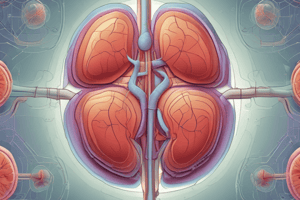Podcast
Questions and Answers
What is the normal potassium concentration in the ECF?
What is the normal potassium concentration in the ECF?
- 6 mmol/L
- 7 mmol/L
- 4 mmol/L (correct)
- 5 mmol/L
Which of the following is involved in the transcellular secretion of potassium?
Which of the following is involved in the transcellular secretion of potassium?
- K/Na ATPase and active transport via calcium channels
- K/Na ATPase and facilitated diffusion via chloride channels
- K/Na ATPase and passive diffusion via potassium channels (correct)
- K/Na ATPase and passive diffusion via sodium channels
What is a common effect of loop diuretics on potassium levels?
What is a common effect of loop diuretics on potassium levels?
- Hyperkalemia (correct)
- No effect
- Variable effect
- Hypokalemia
What is the function of the macula densa?
What is the function of the macula densa?
What is the result of changes in GFR and tubular fluid flow on the afferent arteriole?
What is the result of changes in GFR and tubular fluid flow on the afferent arteriole?
Which mechanism is responsible for the primary secretion of potassium into the tubular lumen?
Which mechanism is responsible for the primary secretion of potassium into the tubular lumen?
What is the primary reason for the development of hyperkalemia when renal function is impaired?
What is the primary reason for the development of hyperkalemia when renal function is impaired?
How do loop diuretics affect the tubular flow and sodium load in the principal cell?
How do loop diuretics affect the tubular flow and sodium load in the principal cell?
What is the paracrine response of the macula densa to changes in GFR and tubular fluid flow?
What is the paracrine response of the macula densa to changes in GFR and tubular fluid flow?
What is the function of the juxtaglomerular complex in the regulation of renal blood flow and GFR?
What is the function of the juxtaglomerular complex in the regulation of renal blood flow and GFR?
Flashcards are hidden until you start studying
Study Notes
Potassium Regulation
- On a normal diet, potassium is secreted in excess, increasing potassium concentration in the extracellular fluid (ECF) from a low level of ~4 mmol/L.
Transcellular Secretion of Potassium
- Occurs in principal cells from peritubular capillary to tubular lumen.
- Involves a 2-step process:
- 1st step: Active transport using the K/Na ATPase pump.
- 2nd step: Passive diffusion via potassium channels into the lumen.
Effect of Renal Function on Potassium Levels
- Renal dysfunction commonly leads to hyperkalemia (high potassium levels).
Loop Diuretics and Potassium
- Loop diuretics have a secondary hyperkaliuric effect due to increased tubular flow and sodium load.
- This leads to increased exchange with potassium at principal cells, resulting in increased potassium levels.
Juxtaglomerular Apparatus
- Comprises the pre-glomerular afferent arteriole and the distal tubular macula densa.
- The macula densa senses changes in GFR/tubular fluid flow, which affects the delivery of NaCl.
- Paracrine response from the macula densa regulates vascular resistance of the afferent arteriole to maintain renal blood flow and GFR.
Potassium Regulation
- On a normal diet, potassium is secreted in excess, increasing potassium concentration in the extracellular fluid (ECF) from a low level of ~4 mmol/L.
Transcellular Secretion of Potassium
- Occurs in principal cells from peritubular capillary to tubular lumen.
- Involves a 2-step process:
- 1st step: Active transport using the K/Na ATPase pump.
- 2nd step: Passive diffusion via potassium channels into the lumen.
Effect of Renal Function on Potassium Levels
- Renal dysfunction commonly leads to hyperkalemia (high potassium levels).
Loop Diuretics and Potassium
- Loop diuretics have a secondary hyperkaliuric effect due to increased tubular flow and sodium load.
- This leads to increased exchange with potassium at principal cells, resulting in increased potassium levels.
Juxtaglomerular Apparatus
- Comprises the pre-glomerular afferent arteriole and the distal tubular macula densa.
- The macula densa senses changes in GFR/tubular fluid flow, which affects the delivery of NaCl.
- Paracrine response from the macula densa regulates vascular resistance of the afferent arteriole to maintain renal blood flow and GFR.
Studying That Suits You
Use AI to generate personalized quizzes and flashcards to suit your learning preferences.



